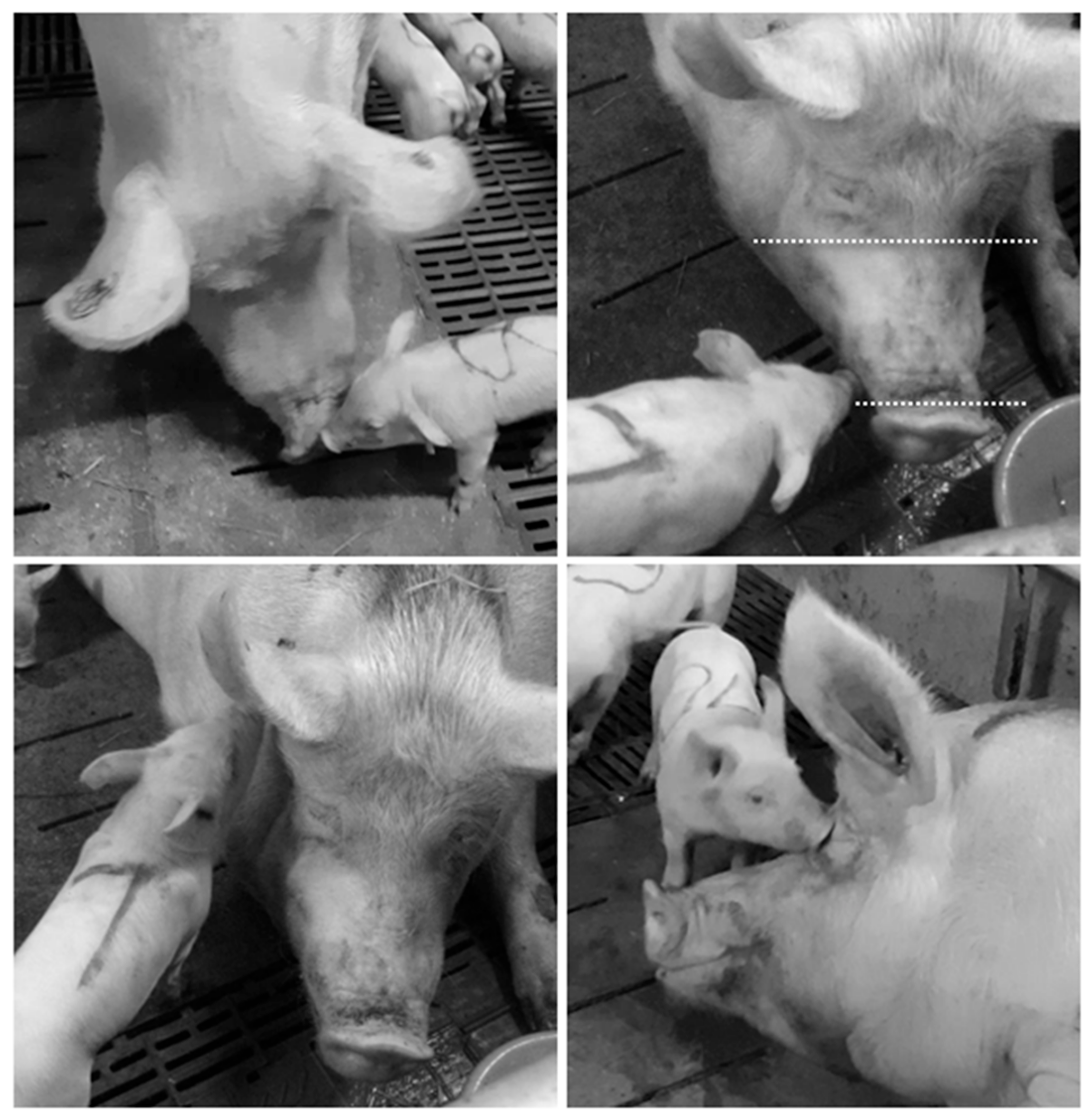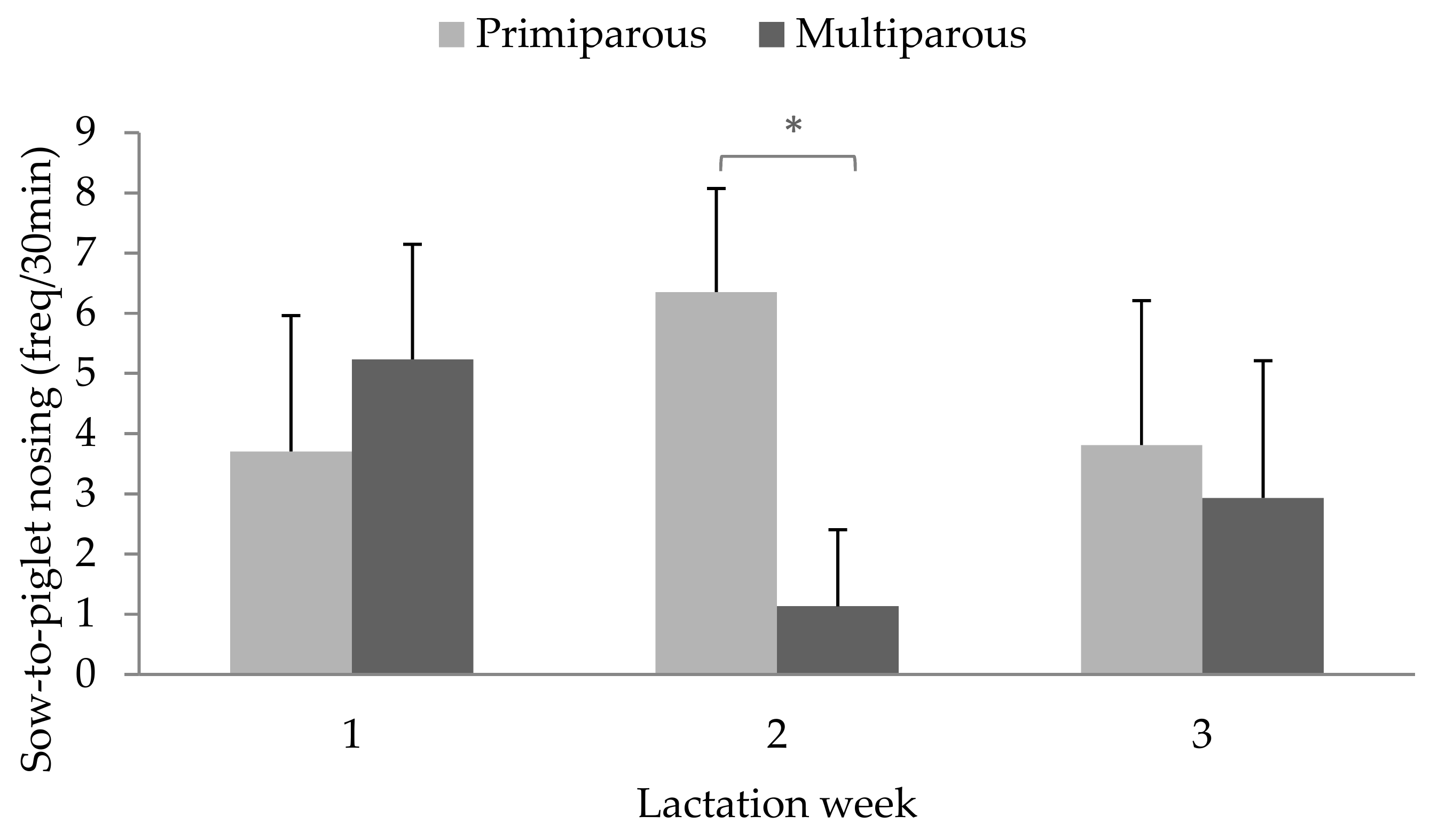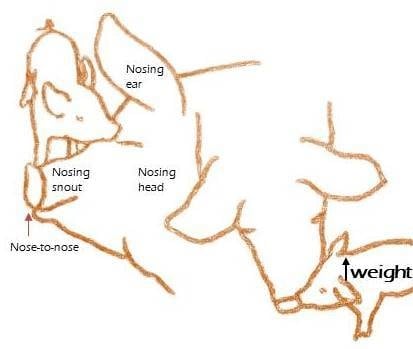Sow-Piglet Nose Contacts in Free-Farrowing Pens
Simple Summary
Abstract
1. Introduction
2. Materials and Methods
2.1. Animals and Housing
2.2. Data Collection
2.3. Data Analysis
3. Results
3.1. Piglet-To-Sow Nosing Behaviour
3.2. Sow-To-Piglet Nosing Behaviour
3.3. Variation in Social Nosing Behaviour Across the Lactation Period
4. Discussion
4.1. Piglet-To-Sow Nosing Behaviour
4.2. Sow-To-Piglet Nosing Behaviour
4.3. Variation in Nosing Behaviour
5. Conclusions
Supplementary Materials
Author Contributions
Funding
Acknowledgments
Conflicts of Interest
References
- Caldji, C.; Tannenbaum, B.; Sharma, S.; Francis, D.; Plotsky, P.M.; Meaney, M.J. Maternal care during infancy regulates the development of neural systems mediating the expression of fearfulness in the rat. Proc. Natl. Acad. Sci. USA 1998, 95, 5335–5340. [Google Scholar] [CrossRef] [PubMed]
- Meaney, M.J. Maternal care, gene expression, and the transmission of individual differences in stress reactivity across generations. Annu. Rev. Neurosci. 2001, 24, 1161–1192. [Google Scholar] [CrossRef] [PubMed]
- Sakhai, S.A.; Saxton, K.; Francis, D.D. The influence of early maternal care on perceptual attentional set shifting and stress reactivity in adult rats. Dev. Psychobiol. 2016, 58, 39–51. [Google Scholar] [CrossRef] [PubMed]
- Edwards, S.A.; Broom, D.M. Behavioural interactions of dairy cows with their newborn calves and the effects of parity. Anim. Behav. 1982, 30, 525–535. [Google Scholar] [CrossRef]
- Searby, A.; Jouventin, P. Mother-lamb acoustic recognition in sheep: A frequency coding. Proc. R. Soc. Lond. B Biol. Sci. 2003, 270, 1765–1771. [Google Scholar] [CrossRef] [PubMed]
- Illmann, G.; Schrader, L.; Spinka, M.; Sustr, P. Acoustical mother-offspring recognition in pigs (Sus scrofa domestica). Behaviour 2002, 139, 487–506. [Google Scholar] [CrossRef]
- Weary, D.M.; Jasper, J.; Hötzel, M.J. Understanding weaning distress. Appl. Anim. Behav. Sci. 2008, 110, 24–41. [Google Scholar] [CrossRef]
- Gundlach, H. Brutfürsorge, Brutpflege, Verhaltensontogenese und Tagesperiodik beim Europäischen Wildschwein (Sus scrofa L.). Ethology 1968, 25, 955–995. [Google Scholar]
- Petersen, V.; Recén, B.; Vestergaard, K. Behaviour of sows and piglets during farrowing under free-range conditions. Appl. Anim. Behav. Sci. 1990, 26, 169–179. [Google Scholar] [CrossRef]
- Stangel, G.; Jensen, P. Behavior of semi-naturally kept sows and piglets (except suckling) during 10 days postpartum. Appl. Anim. Behav. Sci. 1991, 31, 211–227. [Google Scholar] [CrossRef]
- Jensen, P.; Stangel, G.; Algers, B. Nursing and suckling behavior of semi-naturally kept pigs during first 10 days postpartum. Appl. Anim. Behav. Sci. 1991, 31, 195–209. [Google Scholar] [CrossRef]
- Jensen, P. Maternal behaviour and mother—Young interactions during lactation in free-ranging domestic pigs. Appl. Anim. Behav. Sci. 1988, 20, 297–308. [Google Scholar] [CrossRef]
- Jensen, P.; Redbo, I. Behaviour during nest leaving in free-ranging domestic pigs. Appl. Anim. Behav. Sci. 1987, 18, 355–362. [Google Scholar] [CrossRef]
- Hild, S.; Clark, C.C.; Dwyer, C.M.; Murrell, J.C.; Mendl, M.; Zanella, A.J. Ewes are more attentive to their offspring experiencing pain but not stress. Appl. Anim. Behav. Sci. 2011, 132, 114–120. [Google Scholar] [CrossRef]
- Barnett, J.L.; Hemsworth, P.H.; Cronin, G.M.; Jongman, E.C.; Hutson, G.D. A review of the welfare issues for sows and piglets in relation to housing. Aust. J. Agric. Res. 2001, 52, 1–28. [Google Scholar] [CrossRef]
- Whatson, T.S.; Bertram, J.M. Some observations on mother-infant interactions in the pig (Sus scrofa). Appl. Anim. Ethol. 1983, 9, 253–261. [Google Scholar] [CrossRef]
- Chidgey, K.L.; Morel, P.C.; Stafford, K.J.; Barugh, I.W. Observations of sows and piglets housed in farrowing pens with temporary crating or farrowing crates on a commercial farm. Appl. Anim. Behav. Sci. 2016, 176, 12–18. [Google Scholar] [CrossRef]
- Singh, C.; Verdon, M.; Cronin, G.M.; Hemsworth, P.H. The behaviour and welfare of sows and piglets in farrowing crates or lactation pens. Animal 2017, 11, 1210–1221. [Google Scholar] [CrossRef] [PubMed]
- Ahlström, S.; Jarvis, S.; Lawrence, A.B. Savaging gilts are more restless and more responsive to piglets during the expulsive phase of parturition. Appl. Anim. Behav. Sci. 2002, 76, 83–91. [Google Scholar] [CrossRef]
- Harris, M.J.; Li, Y.Z.; Gonyou, H.W. Savaging behaviour in gilts and sows. Can. J. Anim. Sci. 2003, 83, 819–821. [Google Scholar] [CrossRef]
- Gamer, M.; Lemon, J.; Fellows, I.; Singh, P. Irr: Various Coefficients of Interrater Reliability and Agreement; R package version 0.84. 2012. Available online: https://cran.r-project.org/web/packages/irr/irr.pdf (accessed on 26 July 2019).
- R Core Team. R: A Language and Environment for Statistical Computing; R Foundation for Statistical Computing: Vienna, Austria, 2018. [Google Scholar]
- Blackshaw, J.K.; Hagelsø, A.M. Getting-up and lying-down behaviours of loose-housed sows and social contacts between sows and piglets during day 1 and day 8 after parturition. Appl. Anim. Behav. Sci. 1990, 25, 61–70. [Google Scholar] [CrossRef]
- Weary, D.M.; Fraser, D. Calling by domestic piglets: Reliable signals of need? Anim. Behav. 1995, 50, 1047–1055. [Google Scholar] [CrossRef]
- Drake, A.; Fraser, D.; Weary, D.M. Parent-offspring resource allocation in domestic pigs. Behav. Ecol. Sociobiol. 2008, 62, 309–319. [Google Scholar] [CrossRef]
- Camerlink, I.; Bijma, P.; Kemp, B.; Bolhuis, J.E. Relationship between growth rate and oral manipulation, social nosing, and aggression in finishing pigs. Appl. Anim. Behav. Sci. 2012, 142, 11–17. [Google Scholar] [CrossRef]
- Chen, C.; Gilbert, C.L.; Yang, G.; Guo, Y.; Segonds-Pichon, A.; Ma, J.; Evans, G.; Brenig, B.; Sargent, C.; Affara, N.; et al. Maternal infanticide in sows: Incidence and behavioural comparisons between savaging and non-savaging sows at parturition. Appl. Anim. Behav. Sci. 2008, 109, 238–248. [Google Scholar] [CrossRef]
- Wischner, D.; Kemper, N.; Stamer, E.; Hellbruegge, B.; Presuhn, U.; Krieter, J. Characterisation of sows’ postures and posture changes with regard to crushing piglets. Appl. Anim. Behav. Sci. 2009, 119, 49–55. [Google Scholar] [CrossRef]
- Gäde, S.; Bennewitz, J.; Kirchner, K.; Looft, H.; Knap, P.; Thaller, G.; Kalm, E. Genetic parameters for maternal behavior traits in sows. Livest. Sci. 2008, 114, 31–41. [Google Scholar] [CrossRef]
- Ocepek, M.; Andersen, I.L. Sow communication with piglets while being active is a good predictor of maternal skills, piglet survival and litter quality in three different breeds of domestic pigs (Sus scrofa domesticus). PLoS ONE 2018, 13, e0206128. [Google Scholar] [CrossRef]
- Horrell, I.; Hodgson, J. The bases of sow-piglet identification. 1. The identification by sows of their own piglets and the presence of intruders. Appl. Anim. Behav. Sci. 1992, 33, 319–327. [Google Scholar] [CrossRef]
- Nowak, R.; Porter, R.H.; Lévy, F.; Orgeur, P.; Schaal, B. Role of mother-young interactions in the survival of offspring in domestic mammals. Rev. Reprod. 2000, 5, 153–163. [Google Scholar] [CrossRef] [PubMed]





| Methodology | Batch 1 | Batch 2 |
|---|---|---|
| Live observations | 12 sows | - |
| Video observations | 2 sows | 8 sows |
| Data recording | Piglet-to-sow behaviour | Piglet-to-sow behaviour by litter Sow-to-piglet behaviour |
| Sow-to-piglet behaviour | ||
| Nosing during/after suckling | ||
| Piglet teat order (2 to 3 time points) | ||
| Litter size | ||
| Piglet body weight, weekly | ||
| Piglet sex | ||
| Data set | 160 piglets | 8 litters (89 piglets) |
| 3 time points (total 480 data points) | 3 time points (total 24 data points) | |
| 1534 piglet-to-sow occurrences | 555 piglet-to-sow occurrences | |
| 153 sow-to-piglet occurrences | 83 sow-to-piglet occurrences | |
| Analyses | by litter | by litter |
| by piglet |
| Behaviour | Description |
|---|---|
| Nose-to-nose | Piglet touches the nose disc of the sow with its nose disc |
| Nosing snout | Piglet touches or gently rubs the snout of the sow with its nose disc |
| Nosing ear | Piglet touches or gently rubs the ear of the sow with its nose disc without taking the ear into its mouth |
| Nosing head | Piglet touches or gently rubs the head of the sow (excluding nose disc, snout and ear) with its nose disc. Can include licking and nibbling hairs or eyelashes. |
| Sow-to-piglet nosing | Sow initiates contact and gently touches the piglet on any body part with her nose disc |
| Nosing during suckling 1 | During nursing, the piglet stops massaging the udder, or removes itself from the udder, and touches the sow’s nose disc, snout, head or ear with its nose disc |
| Nosing after suckling 1 | Within 1 min after nursing, the piglet touches the sow’s nose disc, snout, head or ear with its nose disc |
© 2019 by the authors. Licensee MDPI, Basel, Switzerland. This article is an open access article distributed under the terms and conditions of the Creative Commons Attribution (CC BY) license (http://creativecommons.org/licenses/by/4.0/).
Share and Cite
Portele, K.; Scheck, K.; Siegmann, S.; Feitsch, R.; Maschat, K.; Rault, J.-L.; Camerlink, I. Sow-Piglet Nose Contacts in Free-Farrowing Pens. Animals 2019, 9, 513. https://doi.org/10.3390/ani9080513
Portele K, Scheck K, Siegmann S, Feitsch R, Maschat K, Rault J-L, Camerlink I. Sow-Piglet Nose Contacts in Free-Farrowing Pens. Animals. 2019; 9(8):513. https://doi.org/10.3390/ani9080513
Chicago/Turabian StylePortele, Katrin, Katharina Scheck, Susanne Siegmann, Romana Feitsch, Kristina Maschat, Jean-Loup Rault, and Irene Camerlink. 2019. "Sow-Piglet Nose Contacts in Free-Farrowing Pens" Animals 9, no. 8: 513. https://doi.org/10.3390/ani9080513
APA StylePortele, K., Scheck, K., Siegmann, S., Feitsch, R., Maschat, K., Rault, J.-L., & Camerlink, I. (2019). Sow-Piglet Nose Contacts in Free-Farrowing Pens. Animals, 9(8), 513. https://doi.org/10.3390/ani9080513






